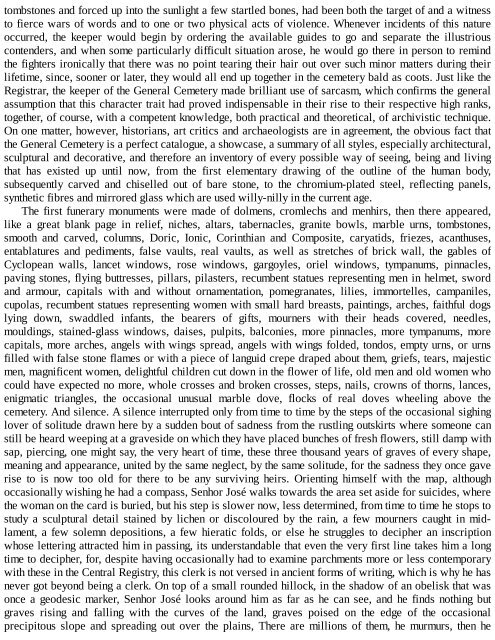You also want an ePaper? Increase the reach of your titles
YUMPU automatically turns print PDFs into web optimized ePapers that Google loves.
tombstones and forced up into the sunlight a few startled bones, had been both the target of and a witness<br />
to fierce wars of words and to one or two physical acts of violence. Whenever incidents of this nature<br />
occurred, the keeper would begin by ordering the available guides to go and separate the illustrious<br />
contenders, and when some particularly difficult situation arose, he would go there in person to remind<br />
the fighters ironically that there was no point tearing their hair out over such minor matters during their<br />
lifetime, since, sooner or later, they would all end up together in the cemetery bald as coots. Just like the<br />
Registrar, the keeper of the General Cemetery made brilliant use of sarcasm, which confirms the general<br />
assumption that this character trait had proved indispensable in their rise to their respective high ranks,<br />
together, of course, with a competent knowledge, both practical and theoretical, of archivistic technique.<br />
On one matter, however, historians, art critics and archaeologists are in agreement, the obvious fact that<br />
the General Cemetery is a perfect catalogue, a showcase, a summary of all styles, especially architectural,<br />
sculptural and decorative, and therefore an inventory of every possible way of seeing, being and living<br />
that has existed up until now, from the first elementary drawing of the outline of the human body,<br />
subsequently carved and chiselled out of bare stone, to the chromium-plated steel, reflecting panels,<br />
synthetic fibres and mirrored glass which are used willy-nilly in the current age.<br />
<strong>The</strong> first funerary monuments were made of dolmens, cromlechs and menhirs, then there appeared,<br />
like a great blank page in relief, niches, altars, tabernacles, granite bowls, marble urns, tombstones,<br />
smooth and carved, columns, Doric, Ionic, Corinthian and Composite, caryatids, friezes, acanthuses,<br />
entablatures and pediments, false vaults, real vaults, as well as stretches of brick wall, the gables of<br />
Cyclopean walls, lancet windows, rose windows, gargoyles, oriel windows, tympanums, pinnacles,<br />
paving stones, flying buttresses, pillars, pilasters, recumbent statues representing men in helmet, sword<br />
and armour, capitals with and without ornamentation, pomegranates, lilies, immortelles, campaniles,<br />
cupolas, recumbent statues representing women with small hard breasts, paintings, arches, faithful dogs<br />
lying down, swaddled infants, the bearers of gifts, mourners with their heads covered, needles,<br />
mouldings, stained-glass windows, daises, pulpits, balconies, more pinnacles, more tympanums, more<br />
capitals, more arches, angels with wings spread, angels with wings folded, tondos, empty urns, or urns<br />
filled with false stone flames or with a piece of languid crepe draped about them, griefs, tears, majestic<br />
men, magnificent women, delightful children cut down in the flower of life, old men and old women who<br />
could have expected no more, whole crosses and broken crosses, steps, nails, crowns of thorns, lances,<br />
enigmatic triangles, the occasional unusual marble dove, flocks of real doves wheeling above the<br />
cemetery. And silence. A silence interrupted only from time to time by the steps of the occasional sighing<br />
lover of solitude drawn here by a sudden bout of sadness from the rustling outskirts where someone can<br />
still be heard weeping at a graveside on which they have placed bunches of fresh flowers, still damp with<br />
sap, piercing, one might say, the very heart of time, these three thousand years of graves of every shape,<br />
meaning and appearance, united by the same neglect, by the same solitude, for the sadness they once gave<br />
rise to is now too old for there to be any surviving heirs. Orienting himself with the map, although<br />
occasionally wishing he had a compass, Senhor José walks towards the area set aside for suicides, where<br />
the woman on the card is buried, but his step is slower now, less determined, from time to time he stops to<br />
study a sculptural detail stained by lichen or discoloured by the rain, a few mourners caught in midlament,<br />
a few solemn depositions, a few hieratic folds, or else he struggles to decipher an inscription<br />
whose lettering attracted him in passing, its understandable that even the very first line takes him a long<br />
time to decipher, for, despite having occasionally had to examine parchments more or less contemporary<br />
with these in the Central Registry, this clerk is not versed in ancient forms of writing, which is why he has<br />
never got beyond being a clerk. On top of a small rounded hillock, in the shadow of an obelisk that was<br />
once a geodesic marker, Senhor José looks around him as far as he can see, and he finds nothing but<br />
graves rising and falling with the curves of the land, graves poised on the edge of the occasional<br />
precipitous slope and spreading out over the plains, <strong>The</strong>re are millions of them, he murmurs, then he



